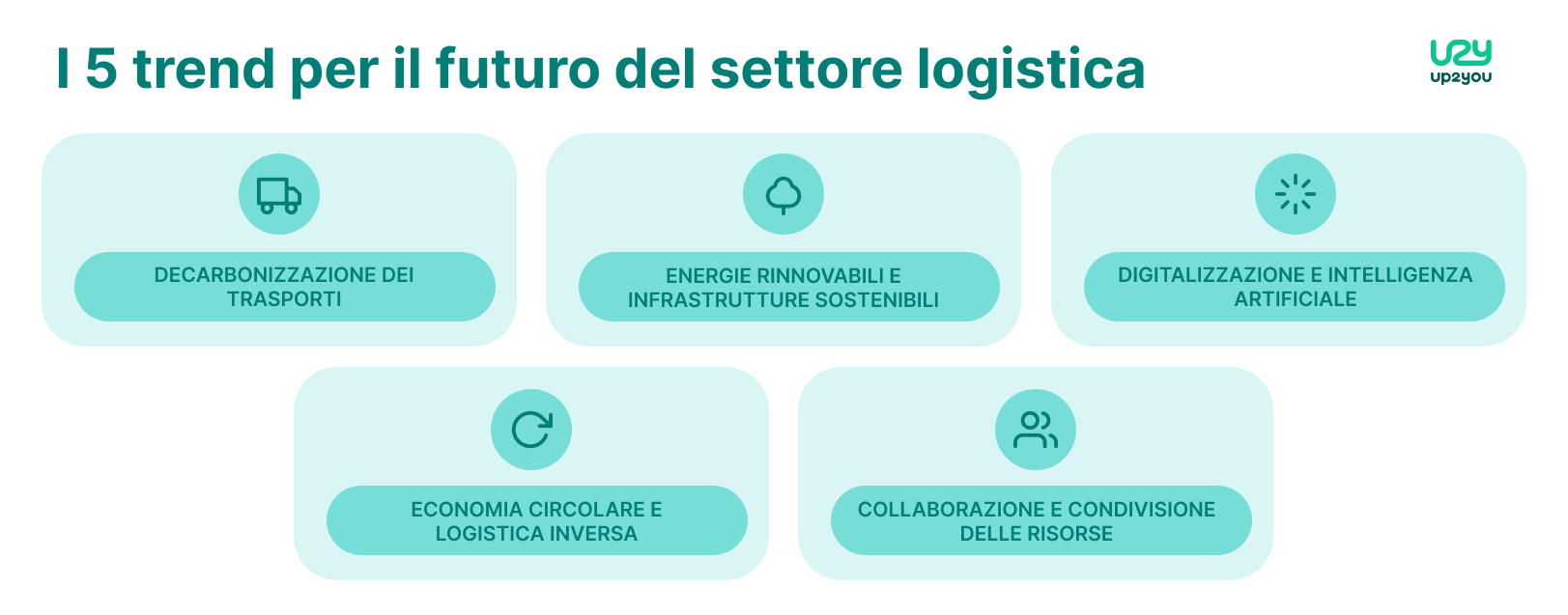What are the environmental impacts of logistics?
Promote sustainability in logistics sector represents one of the most complex environmental challenges to address. The beating heart of global trade and local economies, the transport, warehouse and infrastructure network is also responsible for a significant share of greenhouse gas emissions, urban pollution and the consumption of natural resources. The main criticality environmental logistics is represented by emissions of CO₂ and other climate-altering gases.
According to the World Economic Forum, the transport sector is responsible for about the 21% of global CO₂ emissions, with an increasing share attributable to logistics activities, in particular to urban deliveries of last mile. In fact, it is estimated that, by 2030, these emissions will increase by more than 30% in the top 100 cities in the world, driven by the expansion of e-commerce and the demand for fast shipping.
In addition to climate altering gases, logistics activities, especially on rubber, release harmful pollutants for human health and for the local environment. The main culprits include nitrogen oxides (NOx), fine dust (PM10 and PM2.5), volatile organic compounds and urban noise. The logistics centers, in addition, are often structures of large dimensions, with a high energy intensity and a significant environmental footprint.
The consumption of electricity and heating, if powered by fossil fuels, affects indirect emissions of CO₂ eq (Scope 2 emissions). Added to this are operational waste, water consumption and impacts related to daily management.
Le logistics infrastructures, finally, they require large spaces, often removed from natural ecosystems or agricultural land.
The challenge here is twofold: on the one hand limit land consumption through the redevelopment of abandoned industrial areas (brownfield), on the other hand mitigate environmental impacts of existing structures through interventions by offsetting.
Find out how to promote sustainable logistics in this sector focus created by Up2You.
The 5 trends for the future of the logistics sector
The sector is going through a phase of profound transformation, driven by new operating models, regulatory pressures and consumer expectations.
La sustainable logistics it is no longer an option, but an essential strategic direction for companies that want stay competitive in a context that is increasingly attentive to environmental impacts, social responsibility and technological innovation.
Let's see what are the 5 trends main ones that are redesigning the future of logistics.
1. Decarbonization of transport
The need to drastically reduce the impacts of the sector has prompted many companies to adopt the objective ”Net-Zero”, or the elimination of net emissions by 2050.
This commitment translates into concrete investments: fleets with low or zero emissions, with the use of electric vans, cargo bicycles for the last mile, trucks powered by biofuel or hydrogen for longer routes.
In parallel, they spread compensation projects of residual emissions. In addition to reducing CO₂ eq, these solutions help to improve urban air quality, reducing pollutants such as nitrogen oxides and fine particulate matter.
2. Renewable energy and sustainable infrastructure
Another pillar of sustainable logistics concerns the power: feed operations with Renewable sources It is a priority today. Warehouses and distribution centers have an ever smaller impact thanks to the installation of photovoltaic systems, the purchase of energy from 100% renewable suppliers (solar, wind, hydroelectric) and the introduction of energy efficiency practices.
Solutions such as LED lighting, intelligent automation, the use of sensors for turning on and off machinery, contribute not only to reduce environmental impact, but also to contain operating costs in the medium to long term.
3. Digitalization and artificial intelligence
La digital transformation is a powerful ally of sustainability in logistics. The artificial intelligence (AI) and machine learning are used to optimize delivery routes, predict demand and reduce inefficiencies. By analyzing historical and variable data in real time (traffic, weather conditions, availability of vehicles), algorithms can suggest faster and less impactful itineraries.
Digitalization also includes predictive maintenance of vehicles, to prevent breakdowns and extend their useful life, and the Internet of Things (IoT), which, thanks to connected sensors, monitors consumption, temperatures, driving styles and equipment status in real time.
Finally, the blockchain is established as a key technology to ensure transparency and traceability throughout the supply chain, enabling the monitoring of embedded emissions and the verification of the origin of products.
4. Circular economy and reverse logistics
The logistics of the future will be increasingly circular. Companies are integrating into their processes the reverse logistics, i.e. return logistics: products and materials are brought back by customers to be repaired, refurbished, recycled or disposed of properly.
In the fashion sector, for example, the number of programs of Collection of used clothes. In the industrial sector, the reuse of packaging (such as pallets and containers) is becoming an established practice.
Even the Packaging Enter this paradigm: the demand for sustainable packaging, reusable, compostable or completely absent. Plastic-free shipping, optimized packaging and the elimination of non-recyclable materials are now a criterion of choice for consumers and client companies.
5. Collaboration and resource sharing
One of the most interesting changes is the emergence of a collaborative logistics, in which even competing companies join forces to optimize transport, loads and infrastructure.
Digital platforms and shared hubs they allow the consolidation of shipments to the same destination, reducing empty trips and maximizing the use of vehicles and space.
In the urban environment, several operators are already sharing distribution centers and automated lockers to make last-mile deliveries more efficient. These solutions are often supported by public policies that encourage shared city logistics projects, promoting synergies between companies and reducing overall emissions.
The result is twofold: environmental benefits and greater resilience of supply chain.

What are the obstacles in promoting sustainable logistics
The transition to a more sustainable logistics is today a priority for many companies, driven by the growing attention of customers, institutions and stakeholders to environmental issues.
However, between good intentions and concrete results, they still exist numerous barriers that make this journey complex. In fact, there is no shortage of cases of Greenwashing, or environmental communications that are misleading or not supported by real data, adopted for marketing purposes rather than for a real commitment to sustainability.
One of the main obstacles is represented by high initial costs. Adopting sustainable solutions in logistics requires significant investments, for example for:
- replace diesel vehicles with electric or hydrogen fleets;
- install solar panels on warehouse roofs;
- digitize processes;
- use platforms for ESG monitoring;
- optimize the energy consumption of structures.
For many SMEs in the sector, these costs represent a difficult barrier to overcome without access to public incentives or forms of subsidized financing.
Even when economic benefits are realized in the long term, initial commitment may discourage the adoption of innovative solutions.
Another critical issue is of type cultural and organizational. Logistics is a sector historically characterized by consolidated processes and operating practices that are difficult to change.
Introduce New habits, such as eco-driving courses, the use of telemetry systems or the review of delivery routes, involves:
- staff training and involvement;
- a reorganization of daily activities;
- a transition phase that may temporarily slow down productivity.
In the absence of a culture oriented to corporate sustainability, these changes are likely to encounter strong internal resistances. This is why it is essential that business leadership drives change with consistency, vision and active involvement of all resources.
Finally, many companies are faced with an obvious gap between the stated objectives and their actual implementation.
It is increasingly common to find engagements ESG inserted on websites or within the sustainability report, but without concrete operational plans. According to the Digital Supply Chain Institute:
- 60% of logistics organizations have not yet defined their ESG priorities;
- many companies recognize the importance of sustainability but do not have the tools, skills or internal governance to apply it.
La training plays a crucial role in this context. Develop ESG skills within the organization, it allows us to move from awareness to action, promoting a transformation that is real, measurable and lasting.
Finally, to make the situation even more complex, is the fragmentation of the logistics chain.
The supply chain involves a multiplicity of subjects, shippers, suppliers, couriers, warehouse operators, often disconnected from each other. This makes it difficult to:
- monitor overall environmental performance in a transparent manner;
- collect reliable data (e.g. fuel consumption, type of vehicle);
- promote coordinated interventions along the entire value chain.
In response to this complexity, digital tools are emerging that promote collaboration between different actors. Platforms such as Choral or Climax by Up2You, for example, make it possible to aggregate ESG data, plan shared strategies and improve transparency within the supply chain.
Discover our technologies
What are the most important certifications, ESG ratings or international initiatives in the logistics sector?
On the way to a more sustainable logistics, companies in the sector are progressively adopting international standards, sustainability certifications and ESG rating to measure, improve and report their impact.
These tools not only support the adoption of responsible practices, but they also respond to increasing demands of transparency on the part of customers, investors and regulators.
Below are the main certifications and reference initiatives for sustainable logistics at an international level.ISO 14001 (Environmental Management Systems): provides a framework for managing and improving the environmental performance of organizations.
ISO 45001 (Occupational Health and Safety): standards for preventing injuries and improving well-being in the workplace.
ISO 39001 (Road Traffic Safety): helps organizations reduce the risks of road accidents through structured safety management.
SBTi (Science Based Targets initiative): validates emission reduction objectives in line with climate science and the Paris Agreement.
EcoVadis: ESG rating platform that evaluates companies based on environmental, ethical, social and sustainable supply criteria.
There are also standards and initiatives specifically dedicated to logistics and transport.
TAPA (Transported Asset Protection Association): establishes safety requirements for the protection of goods during transport and storage, with standards required in many high-value supply chains.
LEED (Leadership in Energy and Environmental Design): international certification for sustainable construction, also applied to warehouses and logistics centers. It evaluates the energy efficiency, environmental impact and construction quality of buildings.
SmartWay (EPA): voluntary program of the US Environmental Protection Agency that promotes the reduction of emissions in transportation, with annual awards for the most virtuous operators.
Lean & Green: European initiative aimed at the logistics sector, which rewards companies able to reduce CO₂ emissions by at least 20% over five years. Recognized in many EU countries, it is a virtuous example of how collaboration between public and private can accelerate sustainable transition.






























